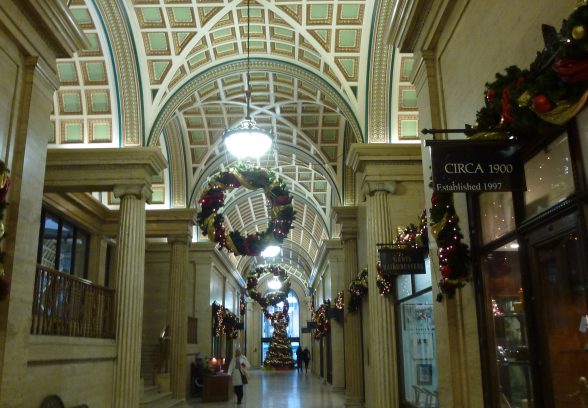This website uses cookies
This website uses cookies to enable it to function properly and to analyse how the website is used. Please click 'Close' to accept and continue using the website.



We are delighted to announce that, after an application by the Twentieth Century Society, India Buildings, Water Street, Liverpool has been upgraded from Grade II to Grade II*. Only 5.5% of England’s listed buildings are in this category, reflecting the exceptional value of the heritage given this status: India Buildings has at last been recognised as part of this elite group.
This stunning building was designed by renowned Liverpool architect Herbert Rowse, having won a 1923 competition judged by Giles Gilbert Scott to build a new office building with shops for the shipping company Alfred Holt & Co. Originally constructed between 1924 and 1932, it was rebuilt to the same designs and plans in 1953 (after being bombed in 1941) under the supervision of Herbert Rowse himself. Rowse had worked in New York and Chicago and brought a taste of Transatlantic styling to Liverpool with both India Buildings and its sister building Martin’s Bank across the road. The building takes up the space of two former city blocks and incorporates the missing street in a central shopping arcade. It survives virtually unaltered externally and has many original internal features of extremely high quality and rarity, making it an exceptional survivor.
Pictured here is the breath-taking Holt’s Arcade shopping arcade, described in Pevsner as ““noble,
tunnel-vaulted arcade of shops”: this can be visited freely, as it forms a public route through the building, giving a taste of the glories of the interior.
In the assessment report English Heritage noted the following reasons for upgrading the building:
Transatlantic influence: “Through its monumental scale, planning, architectural treatment and mixed use, India Buildings emulates the most impressive early-C20 commercial buildings of the US…”;
Architectural interest: “its imposing architectural effect and beauty is achieved by its impressiveness of mass, and its clean surfaces and proportions, rather than ornamentation. Decoration is judiciously placed to enhance, rather than detract from, the building itself…”;
Architects: “it was designed by Herbert Rowse and…represents one of his most significant works”;
Planning interest: “it is an excellent example of a British building following the US-style grid system of town planning”;
Interior quality: “the interior is of a superior quality and incorporates high-quality finishes and materials throughout, including an extensive use of Travertine marble and terrazzo;
Degree of survival: “the building is virtually unaltered externally and retains its major interior elements”;
Group value: “it has strong group value with the Grade II* former Martins Bank (1927-32)”.
The Society put this building forward for the upgrade seeking the greater recognition and protection that a higher listing grade would confer and following fears that inappropriate alterations might threaten the survival of some of its significant features. We hope that this upgrade will ensure that in future any alterations are closely scrutinised and every effort made to maintain the integrity of this exceptional survivor.
Clare Price

Become a C20 member today and help save our modern design heritage.